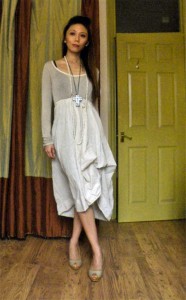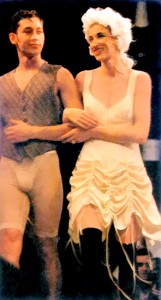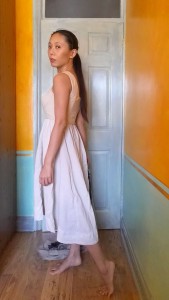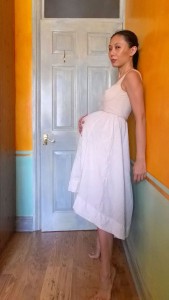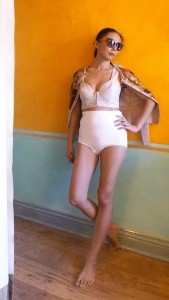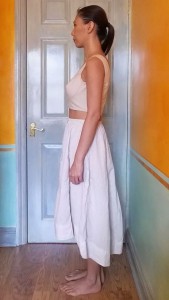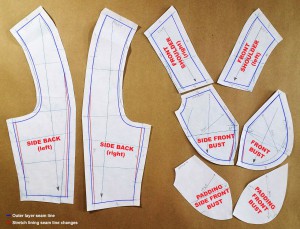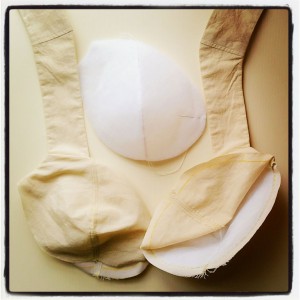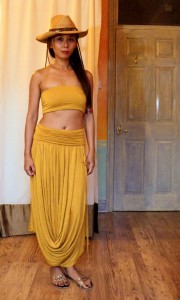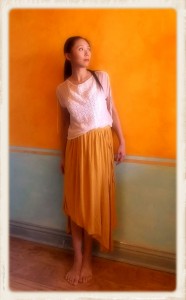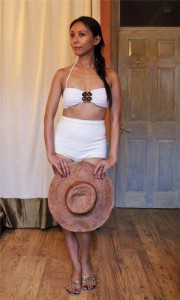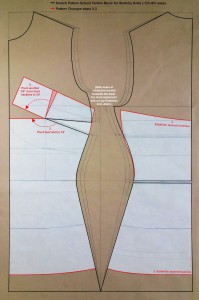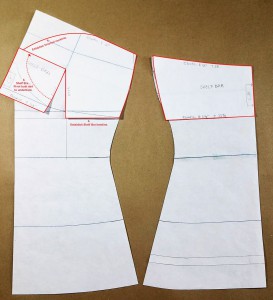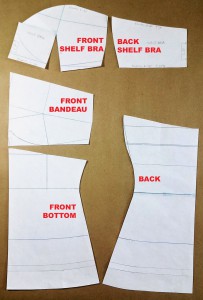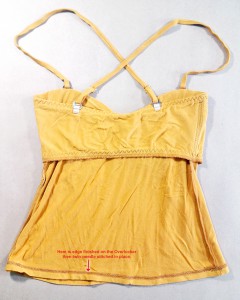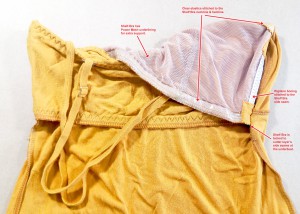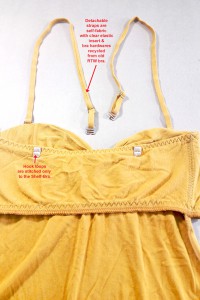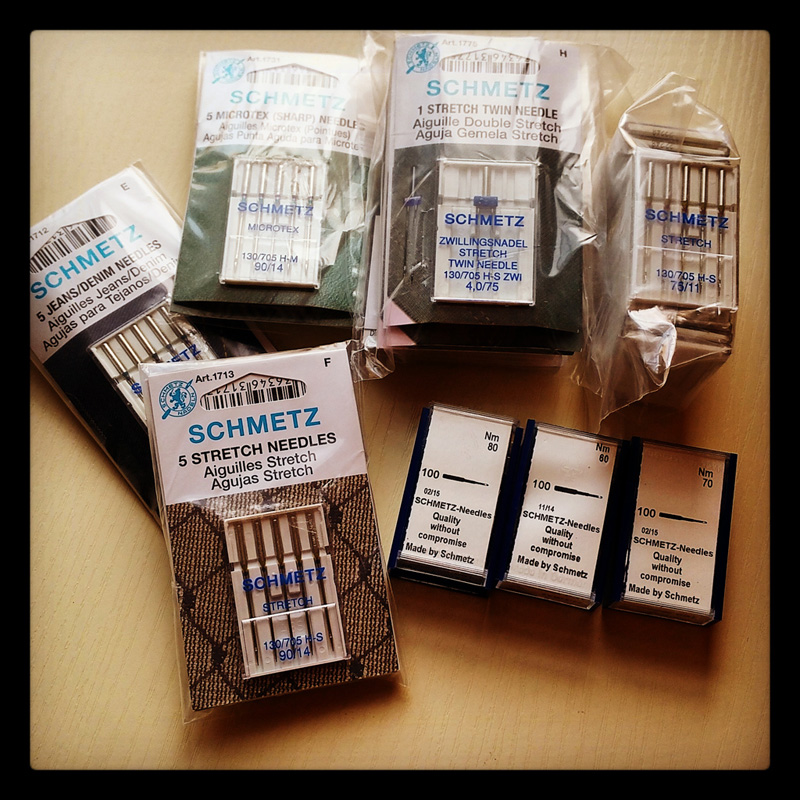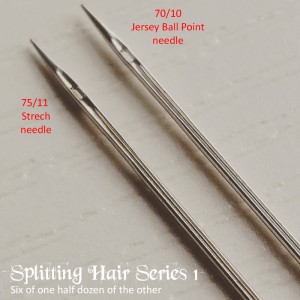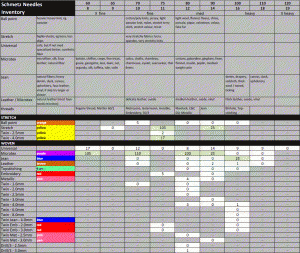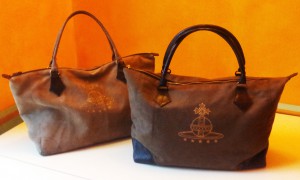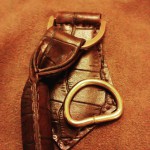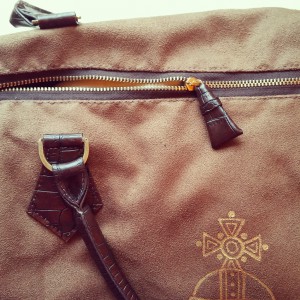As I’m on a roll with the Fix-It’s…Here’s one that I couldn’t even bring myself to wear during MMM’15:
This was originally a RTW from a Camden Market stall. I actually quite liked the original. But because the bodice is made of stretchy knit without much recovery power, the combination of long skirt + gravity made this indecent to wear.
My first attempt at fixing this was an unmitigated failure. I wanted to keep the dress as a pull-on with no closure. But the China Silk/Habutai I used didn’t have the flattering clinging power of the original knit bodice. The resulting silhouette was F-U-G-L-Y, especially in the back.
My latest attempt at fixing this actually started January this year. I was hoping to finish it in time for a holiday in February. But when I tried it on for fit, the bodice felt too tight for a relaxing holiday. Plus there were too many new-to-me design features that I didn’t know how to sew up. So it went back onto the Fix-It Pile.
Fast forward to Fix-It June & July. I tried on the half-finished bodice again. I don’t know how, but the bodice now feels OK!!!??? Maybe recent stresses did what no diet can? 😉 Anyway, I felt ready to resume this Fix-It.
The Inspiration & Design
The funky A-line gore skirt has twill tapes inside on each gore seam which can be used to draw up the skirt into irregular bubble hem. It reminded me of this clipping of a Jean-Paul Gaultier dress from S/S ’91. So my initial design simply replaced the looser pull-on bodice with a corset style bodice.
But I clung to the original dress’ empire waistline, and this was a mistake. I looked like a pregger wench in the resulting dress. To avoid any well meaninged but awkward conversations about when I’m due, I separated the bodice from the skirt. I had just finished the Sari Top Fix-It, so was in a cropped top mood anyway. And you know how I feel about committing to a dress – I much prefer separates that give me more options.
In the same commitment-phobe vain, I made the skirt wearable at waist level and lower down when I’m in a saucy GoT mood! I suppose if I’m ever in a pregger wench mood I can always safety-pin the skirt to the top’s hem… 😉
The Mug & Style Shots
The Pattern
TOP:
- BLOCK: Moulage Block (0-ease).
- As this was meant to be underwired bustier style top, I started out with a skin-tight pattern. This is fine for the stretch lining, but then I got worried that having no ease at all in the outer non-stretch layer would mean another top that I’d never really wear. So I added some ease back in.
- The cup was shifted towards CF slightly in the hope that it’ll give my wide-set girls the barest hint of a cleavage. (Not understanding how bra cups really work, I’m still holding out the hope that it’s possible to cajole the girls into gravity defying positions & shapes!)
- The CF bust dart (which isn’t normally sew up) is pivoted to the princess line for closer fit at neckline. The bust point shifted up slightly and tinsy bit shaved off the cup princess seam below bust point all in the hope of helping my girls defy gravity.
- Not shown: rectangular front closure modesty placket, bias binding for the hem, bias strips for the underwire channels.
SKIRT:
No patterns as this is just the RTW skirt with the top edge turned inside to create the casing for the elastic + existing draw-string.
Fabric & Notions Used
TOP:
- Fabrics:
- Shell: Cotton poplin from Cloth House London. This was the closest I could get to matching the skirt fabric.
- Lining: Cotton/lycra stretch sateen from Cloth House London.
- Notions: Fiberfill padding fabric from Sew Sassy; underwires recycled from old CK bra; Rigilene boning; gold eyes & hooks from eBay.
SKIRT:
- Fabric: recycled from the RTW dress.
- Notions: braided elastic.
Construction Notes
TOP:
- This is my first time attempting a bustier / long-line bra top. So many new-to-me details. I really should have tried a commercial patterns first. Doing it on my own meant brain freeze from juggling too many somewhat-relevant-but-not-entirely advices from scatter sources.
- I roughly followed the instruction in “Create a Foam-Cup Bra” article from Threads 9/2014 (issue 174). The cup padding pattern was drafted without seam allowance, then the pieces butt jointed with zig-zag stitches. The cup assemblage instruction was particular helpful to get a clean finish at neckline and armholes.
- After I decided to turn the dress into separates, I had to ditch the CF zipper idea. I went for hooks & eyes as it fits the bustier look. But I didn’t have any hooks & eyes tape in the right color. So they had to be sewn individually. And for modesty a placket had to be added beneath the CF opening.
- Rigilene boning was added to the lining at side seams, underbust princess seams, & CF opening in the hope of further helping the girls defy gravity.
- The hem was finished with bias binding and stretch stitching to aid breathability while preserving a tight fit. I’ve been using a hybrid of backstitch & slipstitch wherever I need a stretchy binding top-stitch that disappears into the ditch. It’s basically a one-step-backward (right side) -two-steps-forward (hem fold) slipstitch. I haven’t come across this in any of my sewing books, so it’s something I cobbled together for myself. Maybe I’ll do a tutorial on this. I also used it for the Mustard Many-Faced Skirt waistband.
SKIRT:
- Although I could have just used the drawstring for the waistband, I added the elastic in the hope that it’ll help keep the skirt in place whether I wear it at the waist or lower down. I find that if my skirts aren’t fitted from waist to just below high-hip, then they have a tendency to spin around after a few hours’ wear. Since the skirt is A-line, so not fitted in this area, I’m hoping the elastic will grab on to my love-handles and keep the skirt in line.
The Verdict
My cups weren’t particularly successful. Or at least they didn’t do what I wanted them to do. The Fiberfill is too thin for modesty padding. My cup shaping probably isn’t right either as it leaves me with deflated pointy apexes & still droopy old boobs. But the ease I did add in does allow me to wear a proper bra under this tight top. So problem averted this time.
I’m not entirely convinced by my vertical seaming on the cups either. Most bustier tops seem to employ horizontal cup seaming. But this is good enough for now. If only I have a summery pedal pusher to match. And somewhere warmer to wear this in!
The skirt I think will be quite handy. I really should make more fuller skirt. Unless I’m working my day job, pencil skirts are a bit claustrophobic for my unladylike manners, cross-legged sitting style and all.

